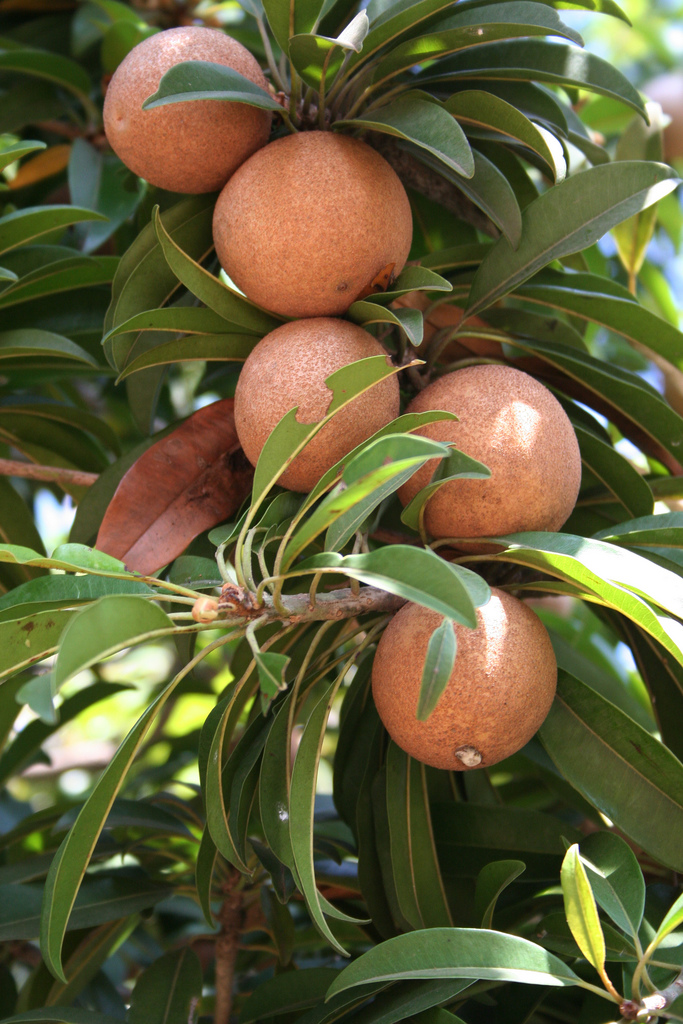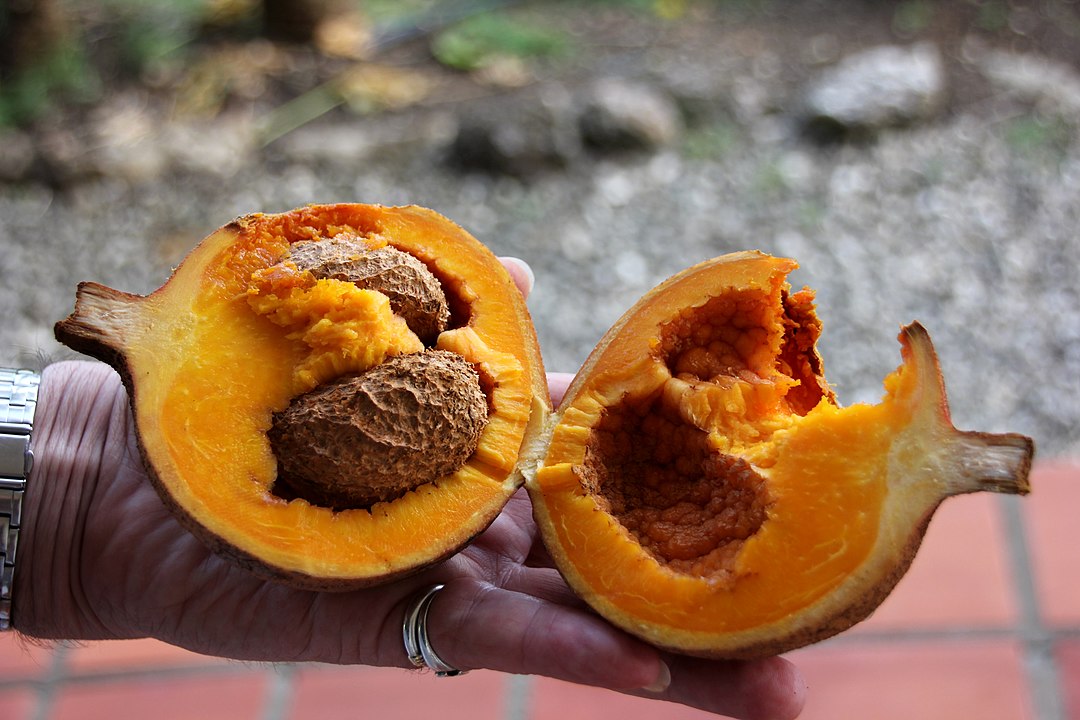Known simply as Mamey in Guyana, this super rare fruit also a berry, can be eaten crunchy or slightly soft, but not mushy. It is enjoyed by many Guyanese, young and old. The texture is similar to a cooked squash and unripe peach. It has the flavor of an apricot with a hint of citrus.
Mammea americana, commonly known as mammee, mammee apple, mamey, Santo Domingo apricot, tropical apricot, or South American apricot, is an evergreen tree of the family Calophyllaceae, whose fruit is edible. It has also been classified as belonging to the family Guttiferae Juss. (1789), which would make it a relative of the mangosteen. It is exotic to Barbados, Venezuela, Surinam, French Guiana, Guyana, just to name a few.
Note: Many times you will hear Guyanese say that “if you eat Mamey and drind rum, you gon die”. This is yet to be proven but you can share you thought in the comment section below.
Origin Of Mamey
Mamey is native to the West Indies and northern South America. It was recorded as growing near Darién, Panama, in 1514, and in 1529 was included by Oviedo in his review of the fruits of the New World.
The mamey apple tree is confined to tropical or subtropical climates. In Central America, the species is found to grow up to an altitude of 1,000 m. It thrives best in rich, deep and well-drained soil, but is very adaptive; it also grows on limestone in Jamaica, in the oolithic limestone of the Bahamas, and on ancient coral bedrock in Barbados as well as coral cays off the coast of Florida.
It is exotic to Barbados, Bahamas, Brazil, El Salvador, Colombia, Bermuda, Venezuela, Ecuador, Guatemala, Surinam, United States of America (Hawaii and Florida), French Guiana, Costa Rica, Virgin Islands (US), Guyana, Mexico, and Panama. It is of very limited occurrence in West Africa (particularly Sierra Leone), Zanzibar, Southeast Asia (Java in Indonesia, Sabah in Malaysia, the Philippines), Queensland in Australia and Hawaii.
Description Of Mamey

Mamey on the Tree | https://zoom50.wordpress.com
The mamey tree, greatly resembling the southern magnolia, reaches 18-21 m (60 to 70 ft) in height, has a short trunk which may attain 0.9-1.2 m (3 or 4 ft) in diameter, and ascending branches forming an erect, oval head, densely foliaged with evergreen, opposite, glossy, leathery, dark-green, broadly elliptic leaves, up to 20 cm (8 in) long and 10 cm (4 in) wide.
The tree’s upright branches form an oval head. Its dark-green foliage is quite dense, with opposite, leathery, elliptic leaves. Leaves are simple, glabrous, coriaceous, opposite, glossy dark-green, broadly elliptic, up to 10 cm (3.9 in) wide and twice as long.
The fragrant flowers, with 4 to 6 white petals and with orange stamens or pistils or both, are 2.5-4 cm (1 to 1 1/2 in) wide when fully open and borne singly or in groups of 2 or 3 on short stalks. They appear during and after the fruiting season: male, female and hermaphrodite together or on separate trees.
The fruit, nearly round or somewhat irregular, with a short, thick stem and a more or less distinct tip or merely a bristle-like floral remnant at the apex, ranges from 10-20 cm (4 to 8 in) in diameter, is heavy and hard until fully ripe when it softens slightly. The skin is light-brown or grayish-brown with small, scattered, warty or scurfy areas, leathery, about 3 mm (1/8 in) thick and bitter. Beneath it, a thin, dry, whitish membrane, or “rag“, astringent and often bitter, adheres to the flesh. The latter is light- or golden-yellow to orange, non-fibrous, varies from firm and crisp and sometimes dry to tender, melting and juicy. It is more or less free from the seed though bits of the seed-covering, which may be bitter, usually adhere to the immediately surrounding wall of flesh. When unripe, the fruit is hard and heavy, but its flesh slightly softens when fully ripe. Fruits of poor quality may be too sour or mawkishly sweet.
Small fruits are usually single-seeded; larger fruits may have 2, 3 or 4 seeds. The seed is russet-brown, rough, ovoid or ellipsoid and about 6.25 cm (2 1/2 in) long. The juice of the seed leaves an indelible stain.
Nutritional Value Of Mamey
Apart from their sweet and tangy taste, Mamey is a good source of nutrients, vitamins and minerals. Consuming 100 gram of Mamey offers 14 mg of Vitamin C (Ascorbic acid), 12.5 g of Carbohydrate, 0.086 mg of Copper, 0.7 mg of Iron, 3 g of Total dietary Fiber and 0.1 mg of Vitamin B6 (Pyridoxine). Moreover many Amino acids like 0.005 g of Tryptophan, 0.037 g of Lysine and 0.006 g of Methionine are also found in 100 gram of this fruit.
5 Health benefits of Mamey
- For Weight Loss – Fruits and juices are proven to be rich in Vitamin C and help to lose fat and maintain healthy weight. Many dieticians and nutritionists recommend including Vitamin C enriched fruits and vegetables in diet charts to remain healthy and fit. Several scientific evidence shows that regular intake of Mamey helps in losing weight considerably. Besides that it will help to lowers insulin level, thus instead of storing sugar and converting it to fats, it utilizes it as a fuel which results in weight loss. Mamey consists of huge amount of Vitamin C 14 mg which is 15.56% of daily recommended value. Therefore, including a Mamey a day to your dietary regimen can keep you fit and healthy for many years.
- Helps Prevent Premature Aging – Copper is an essential trace mineral required for survival. It is a powerful antioxidant, which in presence of antioxidant enzyme superoxide dismutase to safeguard the cell membranes from free radicals. Superoxide dismutase is one of the sturdiest antioxidants that work within the body in the fight against free radicals. Free radicals may attack different organ systems, but are specially well-studied in terms of their effect on aging, which includes age spots, wrinkles, macular degeneration, susceptibility to various types of cancer, and kidney malfunctions. A single cup serving of Mamey contains 100 g Copper which is 9.56% of the daily recommended intake. So consuming Mamey regularly may fulfill copper requirement of your body. Having enough copper in your daily diet can keep you looking younger for longer!
- Immune System – Mamey is loaded with many health endorsing Nutrients, vitamins and minerals. Among other minerals, iron plays an important role in offering strength to immune system of human body. Thus body becomes capable enough to fight against numerous diseases and infections. Red blood cells are essential for providing oxygen to damaged tissues, cells and organs. There would be no hemoglobin without iron; without hemoglobin, there would be no oxygen. The healing process needs iron to happen! Thus Iron plays an important role in providing strength to immune system of human body. Mamey consists of moderate amount of Iron 0.7 mg which is 8.75% of daily recommended value.
- Constipation – Mamey contains significant amounts of Dietary fiber which helps in smooth bowel movements. It consists of moderate amount of dietary fiber 3 mg which is 7.89% of daily recommended value. Mamey intake helps to push out stubborn stools and relieve a person from constipation. Apart from that it helps in dealing with other intestinal disorders as well. Fiber present in mamey helps to bulk up stool and helps stimulate body’s peristaltic motion, which assists to move bowel movements through intestinal tract. In this way fiber present in mamey help to reduce unhealthy digestive problems as well as colorectal cancer.
- Helps Relieve Symptoms of Premenstrual Syndrome – Consuming sufficient amount of vitamin B6 or taking B complex vitamins helps to prevents or treat PMS symptoms. Different research demonstrated that Vitamin B6 helps to fight against nausea, cramps, fatigue, breast pain and also acne which occur before Women’s menstrual cycle. Adequate amount of vitamin B6 can be obtained by regular intake of mamey. It helps with PMS due to its positive effects on neurotransmitters which are liable for pain management within the brain, as well as its role in increasing blood flow and managing hormones. Therefore it is suitable to consume B complex vitamins frequently, particularly the 10 days just before menstruating, for women who experience frequent PMS Symptoms.
Culinary uses Of Mamey
- Salads – Pulp from ripe fruit can be consumed plain along with dash of lime or lemon juice and sugar, or served with cream and sugar or wine, in fruit salads and many more.
- Frozen sherbet – Fresh pulp, blended with sugar, is made into frozen sherbet in Dominican Republic.
- Ade – The juice or syrup of stewed flesh, is seasoned along with sugar and lemon juice to make “ade”.
- Jam – Pulp is steeped in salt water just before cooking with much sugar to prepare a kind of jam in Bahamas.
- Jelly – Slightly under-ripe fruits, rich in pectin, are made into jelly.
- Kolashanpan – Mamey flavored carbonated drink called kolashanpan is made from Mamey which is considered as the national soda in El Salvador.
- Aromatic liqueur – Flowers are distilled to make an aromatic liqueur, Eau de Créole, or Crème de Créole in French West Indies
- Pies or tarts – Sliced mamey pulp may also be cooked in pies or tarts, and may be seasoned with cinnamon or ginger.
- Toddy – Wine is processed from the fruit and fermented “toddy” from the sap of the tree in Brazil.
- Pulp is steeped in wine and sugar for a while prior to consumption in Jamaica.
Traditional Uses Of Mamey
- Mamey has been used in traditional folk medicine for problems of scalp infections, diarrhea, digestive and eye infections in Central America, South America and the Caribbean.
- For parasitic skin diseases pulverized mamey seeds are used in Venezuela.
- Pulverized seeds are considered as a convulsant and an infusion is used for anthelmintic infestation in adults in Brazil.
- Pulverized seeds are combined with rum or coconut oil to deal with head lice and chiggers in Trinidad and Tobago.
- Aromatic liqueur called Creme de Creole or Eau de Creole, which is distilled from the flowers, is used as a tonic or digestive in French West Indies.
- For intermittent fever an infusion of the fresh or dry leaves is used.
- Powdered mamey seeds are used against parasitic skin diseases in traditional medicines of Central and South America.
- Ground seeds are stirred into hot water to get an anthelmintic infusion.
Other Uses Of Mamey
- Large spreading lateral roots of mamey may help to prevent soil erosion.
- It a beautiful ornamental tree and it is often planted for shade around houses, parks and along avenues because of its glossy, dark-green, leaves and dense foliage.
- Wood is strong, fairly decay resistant, used for cabinetwork, rafters, pillars, decorative features of fine houses, fence posts and many more.
- Tannin from the bark is used for home treatment of leather.
- Infusions of the pulverized seeds as well as gum of bark and green fruit rind are utilized as insecticides to kill jiggers, ticks, and fleas.
- Seed extracts are toxic to fish, chicks and hogs.
- Trees are planted along boundaries and fences.
Delish Mamey Pie

Mamey Pie | https://zoom50.files.wordpress.com
Ingredients
For the dough
- 250 g wheat flour
- 80 g sugar
- 125 g of butter to climate
- 1 egg
Instructions
Place the flour in a bowl with the egg and sugar. Knead. Form a ball and bring it to the fridge for an hour. Butter and flour a pie pan, stretch the dough with a rolling pin. Line the pan with the dough. Fill with fresh cold Mamey and bake for 40 minutes. Cool and put powdered sugar.
Ingredients
For the filling
500 g of Mamey, peeled and cubed
250 g sugar
2 cinnamon sticks
1 dl water
Instructions
Peel the Mamey, removing the bitter white cloth covering the pulp. Remove the pulp and cut into cubes. Bring to a simmer with sugar, water and cinnamon. Cook, stirring until soft. Refrigerate.
(Recipe from: https://zoom50.wordpress.com/2010/11/16/mamey-mammee-applemammea-americana/)
Mamey
Exotic to Guyana, this super rare fruit is delicious and healthy and is enjoyed by many Guyanese. It can be found in various supermarkets across Guyana. It has many health benefits and many culinary uses, some of which are – jams, pie or tarts, jelly etc. The Mamey fruit is something we should try to incorporate into our diet.
Article References:
- https://en.wikipedia.org/wiki/Mammea_americana
- https://www.worldwidefruits.com/mammea-americana—mamey-apple.html
- https://www.healthbenefitstimes.com/mammee-apple/
- https://www.britannica.com/plant/mamey-apple
- https://www.fruitsinfo.com/mammee-apple.php







